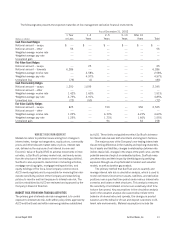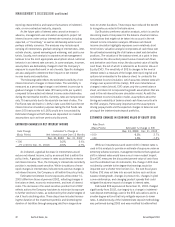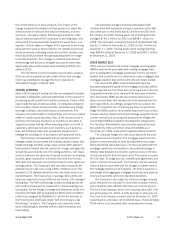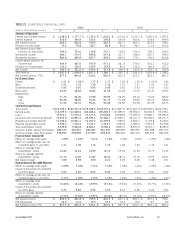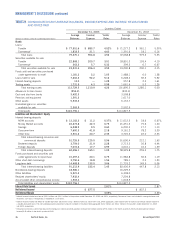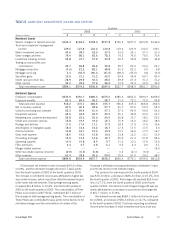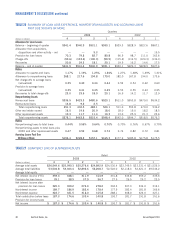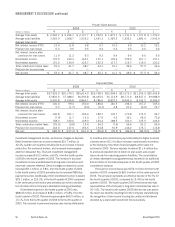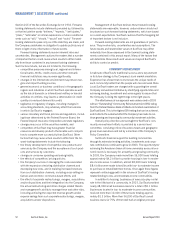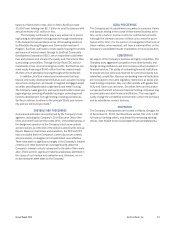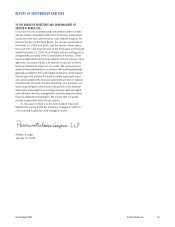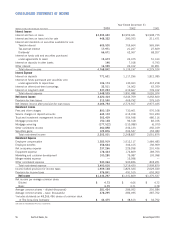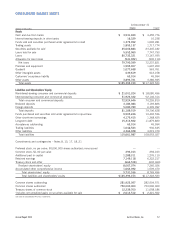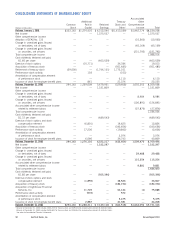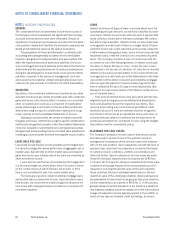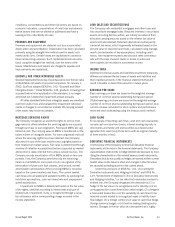SunTrust 2003 Annual Report Download - page 53
Download and view the complete annual report
Please find page 53 of the 2003 SunTrust annual report below. You can navigate through the pages in the report by either clicking on the pages listed below, or by using the keyword search tool below to find specific information within the annual report.
Annual Report 2003 SunTrust Banks, Inc. 51
SUPERVISION AND REGULATION
As a bank holding company and a financial holding company,
the Company is subject to the regulation and supervision of the
Board of Governors of the Federal Reserve System (the Federal
Reserve). SunTrust Bank (the Bank) is a Georgia state bank
which has branches in Georgia, Florida, Tennessee, Alabama,
Virginia, Maryland, South Carolina, and the District of Columbia.
The Bank is a member of the Federal Reserve System, and is
regulated by the Federal Reserve and the Georgia Department
of Banking and Finance.
The Bank is subject to various requirements and restrictions
under federal and state law, including requirements to maintain
reserves against deposits, restrictions on the types and amounts
of loans that may be made and the interest that may be charged
thereon, and limitations on the types of investments that may
be made and the types of services that may be offered. Various
consumer laws and regulations also affect the operations of the
Bank. In addition to the impact of regulation, commercial banks
are affected significantly by the actions of the Federal Reserve as
it attempts to control the money supply and credit availability in
order to influence the economy.
Pursuant to the Riegle-Neal Interstate Banking and
Branching Efficiency Act of 1994, bank holding companies from
any state may acquire banks located in any other state, subject
to certain conditions, including concentration limits. In addition,
a bank may establish branches across state lines by merging
with a bank in another state, subject to certain restrictions.
There are a number of obligations and restrictions imposed
on bank holding companies and their depository institution sub-
sidiaries by federal law and regulatory policy that are designed to
reduce potential loss exposure to the depositors of such deposi-
tory institutions and to the FDIC insurance fund in the event the
depository institution becomes in danger of default or is in
default. For example, under a policy of the Federal Reserve with
respect to bank holding company operations, a bank holding
company is required to serve as a source of financial strength to
its subsidiary depository institutions and commit resources to
support such institutions in circumstances where it might not do
so absent such policy. In addition, the “cross-guarantee” provi-
sions of federal law require insured depository institutions under
common control to reimburse the FDIC for any loss suffered or
reasonably anticipated as a result of the default of a commonly
controlled insured depository institution or for any assistance
provided by the FDIC to a commonly controlled insured deposi-
tory institution in danger of default.
The federal banking agencies have broad powers under
current federal law to take prompt corrective action to resolve
problems of insured depository institutions. The extent of these
powers depends upon whether the institutions in question are
“well capitalized,” “adequately capitalized,” “undercapitalized,”
“significantly undercapitalized” or “critically undercapitalized”
as such terms are defined under regulations issued by each of
the federal banking agencies.
There are various legal and regulatory limits on the extent to
which the Bank may pay dividends or otherwise supply funds to
the Company. In addition, federal and state bank regulatory
agencies also have the authority to prevent a bank or bank hold-
ing company from paying a dividend or engaging in any other
activity that, in the opinion of the agency, would constitute an
unsafe or unsound practice.
FDIC regulations require that management report annually on
its responsibility for preparing its institution’s financial statements,
and establishing and maintaining an internal control structure and
procedures for financial reporting, and compliance with desig-
nated laws and regulations concerning safety and soundness.
The Company’s nonbanking subsidiaries are regulated and
supervised by various regulatory bodies. For example, SunTrust
Capital Markets, Inc. is a broker-dealer and investment adviser
registered with the Securities and Exchange Commission (SEC)
and a member of the New York Stock Exchange, Inc. and the
National Association of Securities Dealers, Inc. (NASD).
SunTrust Securities, Inc. is also a broker-dealer and investment
adviser registered with the SEC and a member of the NASD.
Trusco Capital Management, Inc. is an investment adviser regis-
tered with the SEC. The Company also has one limited purpose
national bank subsidiary, SunTrust BankCard, N.A., which is
regulated by the office of the Comptroller of the Currency.
On November 12, 1999, financial modernization legislation
known as the Gramm-Leach-Bliley Act (the Act) was signed into
law. Under the Act, a bank holding company which elects to
become a financial holding company may engage in expanded
securities activities, insurance sales and underwriting activities,
and other financial activities, and may also acquire securities
firms and insurance companies, subject in each case to certain
conditions. The Company has elected to become a financial
holding company under the Act.
In addition to the Act, there have been a number of legisla-
tive and regulatory proposals that would have an impact on the
operation of bank/financial holding companies and their bank
and nonbank subsidiaries. It is impossible to predict whether or
in what form these proposals may be adopted in the future and,
if adopted, what their effect will be on the Company.
A WARNING ABOUT FORWARD-LOOKING INFORMATION
This Annual Report contains forward-looking statements. The
Company may also make written forward-looking statements in
periodic reports to the Securities and Exchange Commission,
proxy statements, offering circulars and prospectuses, press
releases and other written materials and oral statements made
by SunTrust’s officers, directors or employees to third parties.
Statements that are not historical facts, including statements
about the Company’s beliefs and expectations, are forward-look-
ing statements. These statements are based on beliefs and
assumptions of SunTrust’s management, and on information
currently available to such management. The forward-looking
statements are intended to be subject to the safe harbor protec-
tion provided by Section 27A of the Securities Act of 1933 and


